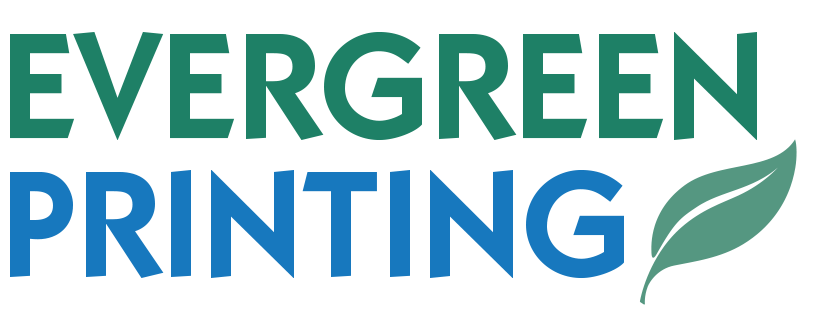Paper is the most widely used material in printing and is therefore the most important factor in minimizing the environmental impact of print. Paper is made primarily from cellulose, the main component of cell walls in plants. Since all plants have cellulose, paper can be made from just about any plant. Globally, trees are the plants of choice even though wood has less cellulose than many other plants and requires more resources to make into paper. Alternatives to trees used for pap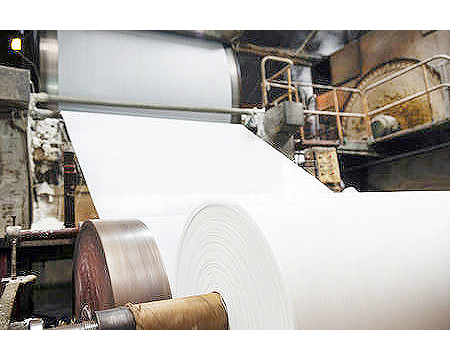 er production include kenaf, hemp, cotton, straw, bamboo, and bagasse. Many papers that include tree-free fibers blend them with tree fibers.
er production include kenaf, hemp, cotton, straw, bamboo, and bagasse. Many papers that include tree-free fibers blend them with tree fibers.
There are many concepts related to the environmental impact of paper manufacturing and disposal. It can be confusing, especially when segments of the paper industry seem intent on obfuscation and many print shops aren’t informed enough to provide accurate information to their customers. I continually research these areas to ensure that I am providing my customers with papers of the highest environmental caliber.
Despite this complexity, selecting paper with the lowest environmental impact is fairly straightforward and should focus on four general areas:
(1) Maximizing post-consumer recycled content
(2) Minimizing virgin content, sourcing it responsibly, and incorporating tree-free fibers
(3) Using less harmful bleaching methods
(4) Selecting paper mills that are making a relative effort to reduce their environmental impact
(1) Maximizing Post-consumer Recycled Content: Paper fibers are either recycled or virgin (non-recycled). In the recycled category, paper is generally understood as either “pre-consumer” recycled or “post-consumer” recycled. Pre-consumer recycled is defined as recycled material that has been recycled before reaching the end user (the consumer). Examples include paper mill waste after the initial papermaking process, 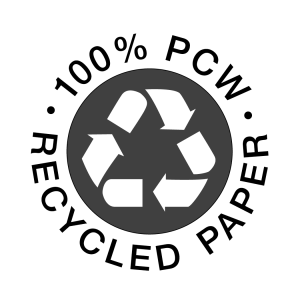 scraps from the conversion of sheets into envelopes, and waste generated by print shops. Post-consumer recycled is defined as recycled material that has reached the end user (the consumer), is diverted from the solid waste stream, and is reprocessed into another product. Post-consumer recycled paper is the paper that goes into the recycling bin at work, school, and at home. Although pre-consumer recycling is critical–and has always been part of the manufacturing process–the emphasis should be on post-consumer waste (PCW) because recycling this material will significantly address our landfill problems and reduce the cutting down of trees. This is because making paper from post-consumer waste is literally making new paper from garbage. Complex issues related to how trees are harvested and the environmental impact of this process are not applicable when using 100% post-consumer recycled paper. In addition to saving trees (i.e. forests and habitat), the amount of resources used and pollution emitted are dramatically less for 100% post-consumer paper when compared to producing virgin paper from trees (see the graphical statistics below). Although recycled paper has been part of our vocabularies for a very long time, more than 90% of the total quantity of printing and writing papers is still made from 100% virgin tree fibers. As consumers, we must specify more responsible papers; as citizens, we must push our elected representatives and take direct action to improve the current situation.
scraps from the conversion of sheets into envelopes, and waste generated by print shops. Post-consumer recycled is defined as recycled material that has reached the end user (the consumer), is diverted from the solid waste stream, and is reprocessed into another product. Post-consumer recycled paper is the paper that goes into the recycling bin at work, school, and at home. Although pre-consumer recycling is critical–and has always been part of the manufacturing process–the emphasis should be on post-consumer waste (PCW) because recycling this material will significantly address our landfill problems and reduce the cutting down of trees. This is because making paper from post-consumer waste is literally making new paper from garbage. Complex issues related to how trees are harvested and the environmental impact of this process are not applicable when using 100% post-consumer recycled paper. In addition to saving trees (i.e. forests and habitat), the amount of resources used and pollution emitted are dramatically less for 100% post-consumer paper when compared to producing virgin paper from trees (see the graphical statistics below). Although recycled paper has been part of our vocabularies for a very long time, more than 90% of the total quantity of printing and writing papers is still made from 100% virgin tree fibers. As consumers, we must specify more responsible papers; as citizens, we must push our elected representatives and take direct action to improve the current situation.
I source nationally in order to stock the highest post-consumer recycled papers available. All my house sheets (uncoated and coated papers) and envelopes are 100% post-consumer recycled. All house window envelopes have windows made from corn starch (polylactic acid), translucent paper (glassine), or are open (no window material) instead of using petroleum-based plastic windows. I am also one of just a few print shops in the entire country that prints on recycled carbonless paper. And, of course, 100% of my shop’s waste paper is recycled.
Environmental benefits of using 100% post-consumer recycled paper
instead of virgin paper made from trees*:

0
Trees Cut Down

33%
Less Energy Used

49%
Less Water Used

40%
Less Solid Waste

50%
Less Particulates

37%
Less Greenhouse Gases

66%
Less Hazardous Air Pollutants
* These calculations are based upon research conducted by Environmental Defense Fund and other members of the Paper Task Force. For more information, visit the Environmental Paper Network website at environmentalpaper.org.
(2) Minimizing Virgin Content, Sourcing it Responsibly, and Incorporating Tree-free Fibers: Despite my focus on using 100% post-consumer recycled papers, sometimes there is no such paper option available for a particular project. When I use papers that contain virgin tree fibers, these papers are always a blend of post-consumer recycled and virgin material. I do not print on 100% virgin paper made from trees and all papers I use meet, and usually greatly exceed, federal recycling standards (30% post-consumer recycled content for uncoated paper and 10% post-consumer recycled content for coated paper). Sadly, these federal standards have not increased since the Clinton Administration and most paper manufactures do what is minimally required. The result is that over 90% of printing papers available today still contain zero post-consumer recycled content. Although there are a handful of 100% post-consumer recycled papers, the industry has made little effort to increase the percentage of post-consumer recycled content in their recycled/virgin blended papers beyond the federal minimum requirements.
The virgin tree fiber content of the papers I use must be harvested using sustainable practices. Although there is no perfect certification process–and several sham certification organizations created by industry–the best certification organization that currently exists is the Forest Stewardship Council (FSC). Founded in 1993, the FSC accredits third party certification organizations and has developed a comprehensive standard of conduct to manage forests in a relatively environmentally responsible, socially beneficial, and economically viable way. The FSC “chain of custody” is intended to ensure that wood and forest products meet standards from extraction until the end product is sold to a consumer. Regarding paper, all the mills I buy from are FSC chain of custody certified. There are 10 principles and about 70 criteria used in FSC certification, including complying with all laws and treaties, protecting worker rights and working conditions, respecting indigenous peoples’ rights and local community relations, and harvesting trees in a permanently sustainable way that maintains, conserves, and/or restores the affected ecosystem. To download a copy of the latest FSC principles and criteria, click here.
Despite the existence of FSC certification, it should in no way be interpreted that FSC-certified virgin paper is environmentally comparable to post-consumer recycled paper. In addition to the above graphic comparison between 100% post-consumer recycled paper and virgin paper, there are deficiencies in FSC criteria and practices. For examples, the FSC allows for the cutting of old-growth or primary forests, lets forests be replaced with tree plantations, and permits companies to combine non-FSC-certified materials with FSC-certified materials (calling it “controlled wood”) for its least environmental “FSC Mix” label. Moreover, the enormous scale of certifying over 210 million hectares of forest in 90 countries has brought with it a certain level of corruption and failure. FSC certification should be understood as a decent tool to make relatively better decisions about extracting virgin wood products, not as a panacea so we don’t have to think about consumption and deforestation any more. Unfortunately, many end users are now more concerned with specifying FSC-certified virgin paper rather than requiring post-consumer recycled papers for their projects.
Another consideration in selecting the most environmentally responsible papers is the inclusion of tree-free fibers and agricultural residues. As mentioned at the top of this page, alternatives to trees used for paper production include kenaf, hemp, cotton, straw, bamboo, and bagasse. As long as these tree-free materials have lower environmental, economic, and social costs compared to virgin tree fibers, they should be made into tree-free papers or blended with post-consumer recycled content and be considered a component of environmentally responsible paper production. Sometimes this means growing crops such as kenaf and hemp for paper production. Other times it means using agricultural residues from other crops and using these in paper production. For examples, I occasionally print on 100% cotton paper that is made from linters (a byproduct of the cotton ginning process) and on bagasse (sugarcane fiber left over after juice extraction). These tree-free fibers are fully recyclable in the post-consumer recycled papermaking process.
A final consideration is the use of synthetic substrates (i.e. plastics) in printing. As the printing industry shrinks because of electronic communication, it is trying to create new markets for printing. Many of these markets revolve around printing on plastics, almost exclusively virgin plastics. Currently, there is little interest in developing post-consumer recycled plastic substrates or developing plastic recycling capabilities. The last thing our environment needs is more plastic ending up in landfills and littering our lands and water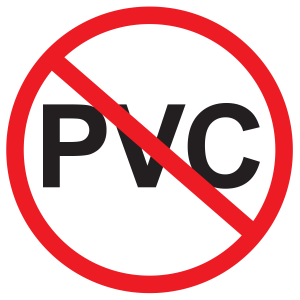 ways/oceans. This is why I rarely print on synthetic substrates. The infrequent exception is that I occasionally print stickers for outdoor use because paper doesn’t hold up well. The printing industry standard has been to use polyvinyl chloride or “vinyl” (PVC, the #3 plastic) because it is cheap and performs well. However, PVC is generally regarded by public health officials and environmental organizations as the most toxic plastic because of the serious health and environmental pollution issues associated with its manufacture, use, and disposal. Instead of PVC, I use polyester (#1 plastic) or polypropylene (#5 plastic) sticker material.
ways/oceans. This is why I rarely print on synthetic substrates. The infrequent exception is that I occasionally print stickers for outdoor use because paper doesn’t hold up well. The printing industry standard has been to use polyvinyl chloride or “vinyl” (PVC, the #3 plastic) because it is cheap and performs well. However, PVC is generally regarded by public health officials and environmental organizations as the most toxic plastic because of the serious health and environmental pollution issues associated with its manufacture, use, and disposal. Instead of PVC, I use polyester (#1 plastic) or polypropylene (#5 plastic) sticker material.
When I print on papers that are less than 100% post-consumer recycled, I prioritize papers with the highest percentage of post-consumer recycled fiber. All virgin fiber from trees is FSC-certified and manufactured in a paper mill with an FSC chain of custody certification. Papers made with tree-free fibers are used if they have lower environmental, economic, and social costs compared to virgin tree fibers. I infrequently print on synthetic substrates (plastics) and never print on PVC.
(3) Using Less Harmful Bleaching Methods: Paper pulp is bleached during the papermaking process to make paper whiter and to remove lignin from paper fibers. The environmental impacts of bleaching are very significant, yet these are often overlooked by print shops and consumers. There are a variety of bleaching options, but chlorine has been the bleaching chemical of choice. Although effective, elemental chlorine gas produces hundreds of toxic byproducts called organochlorines, including dioxins and furans. 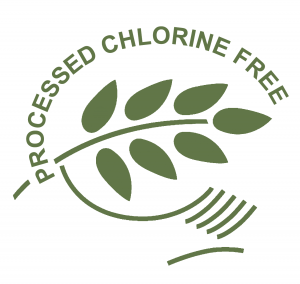 Dioxin is among the most dangerous chemicals known and can cause cancers as well as immune, nervous system, endocrine, and reproductive harm in very small amounts. Feeling public pressure and fearing that the Environmental Protection Agency (EPA) would eventually ban elemental chlorine in papermaking, paper mills in the U.S. replaced elemental chlorine with chlorine derivatives such as chlorine dioxide (known as “Elementally Chlorine Free” or ECF bleaching) by the early 2000’s. Although significantly less toxic than elemental chlorine, ECF bleaching still produces hundreds of toxic organochlorines. The paper industry fought tooth and nail against safer bleaching alternatives to elemental chlorine and ECF, known as “Totally Chlorine Free” or TCF bleaching. TCF uses non-chlorine/chlorine derivative processes such as hydrogen peroxide and sodium hydrosulphite to bleach virgin paper and remove lignin. Although TCF is a little more common in Europe, it is rarely used in North America. ECF remains the most common method of bleaching virgin paper in mills around the world. The last category related to paper bleaching is “Processed Chlorine Free” or PCF, defined as post-consumer recycled paper in which the recycled content is either unbleached or bleached without chlorine or chlorine derivatives. This is done at a deinking mill, the intermediary step between the collection of post-consumer recycled paper and it’s use in the making of new paper products. If there is virgin fiber present in this paper, it must be Totally Chlorine Free (TCF). PCF is the strongly preferred environmental choice because of its use of post-consumer recycled fibers and the absence of chlorine or chlorine derivatives in the remanufacturing process.
Dioxin is among the most dangerous chemicals known and can cause cancers as well as immune, nervous system, endocrine, and reproductive harm in very small amounts. Feeling public pressure and fearing that the Environmental Protection Agency (EPA) would eventually ban elemental chlorine in papermaking, paper mills in the U.S. replaced elemental chlorine with chlorine derivatives such as chlorine dioxide (known as “Elementally Chlorine Free” or ECF bleaching) by the early 2000’s. Although significantly less toxic than elemental chlorine, ECF bleaching still produces hundreds of toxic organochlorines. The paper industry fought tooth and nail against safer bleaching alternatives to elemental chlorine and ECF, known as “Totally Chlorine Free” or TCF bleaching. TCF uses non-chlorine/chlorine derivative processes such as hydrogen peroxide and sodium hydrosulphite to bleach virgin paper and remove lignin. Although TCF is a little more common in Europe, it is rarely used in North America. ECF remains the most common method of bleaching virgin paper in mills around the world. The last category related to paper bleaching is “Processed Chlorine Free” or PCF, defined as post-consumer recycled paper in which the recycled content is either unbleached or bleached without chlorine or chlorine derivatives. This is done at a deinking mill, the intermediary step between the collection of post-consumer recycled paper and it’s use in the making of new paper products. If there is virgin fiber present in this paper, it must be Totally Chlorine Free (TCF). PCF is the strongly preferred environmental choice because of its use of post-consumer recycled fibers and the absence of chlorine or chlorine derivatives in the remanufacturing process.
All my house sheets and envelopes are 100% processed chlorine free (PCF). When using papers that are not 100% PCF, I will prioritize TCF papers if available and will favor mills using less toxic ECF processes.
(4) Selecting Paper Mills Making a Relative Effort to Reduce their Environmental Impact: Making paper is a capital-intensive process that consumes large amounts of energy, water, and chemicals. It also produces waste in the form of air pollution, water discharge, and solid waste. Does it matter which paper company is producing your paper or are they all the same? Yes, it matters what company is making your paper for both environmental and labor reasons. Labor considerations are covered in the “Union Shop” page. Regarding the environment, I purchase paper only from companies that are making a relative effort to reduce the environmental impact of paper production. I say “relative” because pulp and paper manufacturers have had a long history of putting the environment and workplace safety second to profits. With that said, some mills are making more of an effort than others. Aspects of this effort include the level of post-consumer recycled paper a company is producing relative to its overall paper production, the amount of resources used in its paper production, the pollution emitted from mills during production and distribution, how the paper mill is powered, and meaningful third party environmental certifications.
It takes a tremendous amount of energy and water to manufacture paper. The most significant way a paper mill can reduce its energy and water consumption per ton of paper produced is to make high post-consumer recycled papers. As the graphical statistics illustrate at the end of section (1) above, making 100% post-consumer recycled paper consumes 33% less energy and 49% less water than manufacturing 100% virgin paper from trees. Moreover, the difference in pollution emitted during the production of 100% post-consumer recycled paper compared to virgin paper made from trees is also significant: 40% less solid waste, 50% less particulates, 37% less greenhouse gases, and 66% fewer hazardous air pollutants. All the mills I buy from prioritize post-consumer recycled paper and almost all make multiple 100% post-consumer recycled papers. I also support mills that are increasing the proportion of post-consumer recycled paper in their overall paper output.
Paper mills are huge capital investments, so improvements can take time to implement. Mills that I buy from are making efforts to use less resources in paper production and emit less pollution in the process. For example, one mill has installed new steam plants that have significantly reduced the amount of air pollutants emitted during production. Another mill has replaced its coal-fired boilers with natural gas and has installed better controls on its wood-fired boiler, pulping, and recovery processes that have significantly reduced its nitrogen oxide and sulfur dioxide emissions.
Another way a paper mill can reduce its environmental impact is related to the source of the energy used to power its mill. A couple of mills I use are powered with cleaner sources of energy. One mill built its own hydroelectric power plant which has provided 100% of the paper mill’s power for nearly a century. Another mill uses gas produced from a decomposing landfill site, via an 8-mile pipeline, to power 93% of the mill’s electricity needs. This biogas energy source has reduced the mill’s greenhouse gases by 70,000 tons every year. Not only are these direct power sources cleaner, but the emissions from the mills are also dramatically reduced. These direct power source examples should not be confused with “renewable energy certificates” (or RECs). RECs are market-based instruments that represent the environmental value of one megawatt hour of electricity so an entity can claim the benefits of cleaner electricity generation even though a dirtier form was actually used. Buying RECs does not magically erase the environmental impact of powering a manufacturing facility with dirtier energy sources or necessarily result in significant investment in cleaner energy, no matter how many pictures of wind turbines are placed on marketing materials and websites.
Lastly, I use mills that participate in meaningful third party environmental certification programs. I say “meaningful” because there are several certification organizations/programs that are merely front groups for the forest products industry, are primarily concerned with trading energy credits, or have such weak criteria that the benefit of these certifications is questionable. Deciding which certifications should be valued requires ongoing research. With regard to paper production, I have already mentioned Forest Stewardship Council (FSC) certification as a way to make relatively better decisions about the extraction of virgin wood products. In addition, arguably the highest and most comprehensive standards for environmental responsibility in the paper industry is Canopy’s Ancient Forest Friendly certification. Almost all the mills I buy from are Ancient Forest Friendly certified and almost all the papers I print on are listed as “superior” in Canopy’s “Ecopaper Database”, found here.
Over 95% of the paper I print on is made in the United States and the remainder is made in Canada, Italy, and Germany. This sourcing makes it easier to assess the environmental caliber of the mills making the paper that I use. I purchase paper only from companies that are making a relative effort to reduce the environmental impact of paper production.
